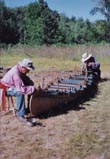



The following canoes were built by people who love birchbark canoes. They are not in the business of building canoes. Some even undertook the task with no more training in the craft than reading a book or watching a video. Here are their stories. Salute!
Click on any image to view full size
Picture on left is Joe's first attempt. The other two are Joe's second canoe.
"I was given the book "Survival of the Bark Canoe" by a friend and it really inspired me to try to make my own canoe with natural materials and hand tools. The two sources of instruction I used were "The Bark Canoes and Skin Boats of No. America", and a 3 page article titled "How an Indian Birch Bark Canoe is Made" from the July 29, 1890 edition of Harper's Young People magazine supplement. This article is packed with detailed builing instructions and diagrams for a Malecite bark canoe and I followed it closely. I got information on where to find good birch trees in New Hampshire and the black spruce roots in a huge bog in Maine from a well-known snowshoe maker from Conway, New Hampshire named Treffle Bolduc. I stripped the bark off the trees myself and harvested all the spruce roots from the bog wearing hip boots. I had some telephone advice from Steve Cayard and Bart Howe on two occasions when I was stuck and discouraged. My first canoe was 13.5 feet long and the second is 16 feet. I kept a log of time spent building the second one and it totaled approximately 360 hours. This included all time driving, gathering materials, and the construction. I used a crooked knife purchased from Kestrel Tools and a small axe mostly for making the wooden members. This was my first significant woodworking project. I'm beginning to work on the thwarts and frame for the 3rd canoe this spring. We have used the first two canoes for lake paddles and canoe camping trips quite a bit. It is really satisfying to do that in a canoe that you have made from scratch yourself."
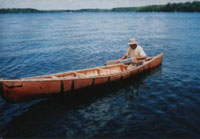
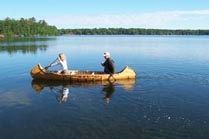
The picture on the left is Jack's first canoe he built with no other instruction
than the pages of The Bark Canoes and Skin Boats of North America. The next picture
is the second canoe Jack built after he took a class at The Bark Canoe School.
The class was in 2003 and this canoe was completed in the summer of 2004.
"I was given the book,"The Survival of the Bark Canoe", and after reading it thought
it would be neat to try to make one. I still didn't totally understand the process,
or know what a crooked knife was. Two or three years ago I started searching the
internet for information, got Adney's book about bark canoes and a crooked knife
from the Bark Canoe Store. After reading the book a few times I was finally able
to understand how the process worked. We own some land in northern Wisconsin that
had the raw materials, so I was all set. I was going to build the Malecite canoe
that Adney describes. I found a couple of cedars that had blown down that were long
and clear. That winter I split out enough to make the frame, ribs, sheathing etc. I
had also gotten what I thought was enough (ended up going back 2- 3 times for more)
black spruce root and split it out. That spring I peeled the bark off a couple birch
trees and leveled off a building bed at the hunting shack. Then I built it as described
in the book. I used a wood fired stove that I used in making maple syrup to boil water
for bending the ribs and stem pieces. I used the real spruce gum to pitch the canoe,
after finally figuring out how to get it. I hope this helps."
Jack Gribble
Wisconsin
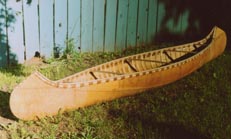
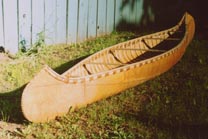
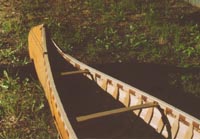


The first three pictures show the first canoe Pierre built while under the supervision of
John Lindman. The last two photos are of a canoe made by Pierre completely on his own a few
months later.
Pierre was instructed in how to build a birchbark canoe while assisting on a canoe
he bought from John. On a pilot project to see if a student could successfully build
his own canoe under supervision Pierre built this 14ft Ojibwe. It has a single sheet of
bark for the hull, white ash gunwales and thwarts. It was not pitched at that time
because it was going to be transported cross country and pitched once home. Pierre plans
to have a fleet of birchbark canoes for a project he is creating.
Pierre Blin
Peterborough,ON
509.327.7902 voice 509.327.7889 facsimile barkcanoe@earthlink.net e-mail
Home Canoes Classes Furnishings Accessories Tips News and New Stuff Consignment Canoes